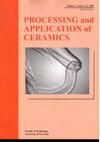Doping effects in (Ba0.85Ca0.15)(Hf0.1Ti0.9)O3 lead-free piezoelectric ceramics prepared via powder injection moulding using simple binder
IF 0.8
4区 材料科学
Q3 MATERIALS SCIENCE, CERAMICS
引用次数: 3
Abstract
To improve densification of the (Ba0.85Ca0.15)(Hf0.1Ti0.9)O3 (BCHT) ceramics prepared via powder injection moulding, MnO2 and Li2CO3 were used as sintering aids. The BCHT ceramics doped with different Mn- and Li-amount prepared by powder injection moulding in which paraffin was used as injection binder, have rather pure perovskite structure with complicated polymorphic ferroelectric phase coexistence. Polyhedral grains combined with nearly round shape grains with increased relative density and larger gains size were obtained at appropriate doping amount, related to the formation of liquid phase during sintering and increased mobility of ions due to the generation of point defects caused by heterovalent cations doping. TheMn- and Li-doped BCHT ceramics are displacement driven ferroelectrics with apparent diffused transition characteristic at different extent, relating to the morphotropic phase boundary composition and the variation of point defects induced by doping. Comparable or surpassing electrical performance was acquired, especially the dielectric breakdown strength was increased due to the improved sinterability. With appropriate doping amount, piezoelectricity larger than 300 pC/N can be obtained in the Mn- and Li-doped BCHT ceramics poled under low electric field.简单粘结剂粉末注射法制备(Ba0.85Ca0.15)(Hf0.1Ti0.9)O3无铅压电陶瓷的掺杂效应
为了提高粉末注射法制备的(Ba0.85Ca0.15)(Hf0.1Ti0.9)O3 (BCHT)陶瓷的致密性,采用MnO2和Li2CO3作为助烧剂。以石蜡为注射结合剂,采用粉末注射成型法制备了不同Mn-和li掺杂量的BCHT陶瓷,具有较纯的钙钛矿结构和复杂的多晶铁电相共存。在适当的掺杂量下,可以得到相对密度增大、增益尺寸增大的多面体晶粒与近圆形晶粒结合的晶粒,这与烧结过程中液相的形成和杂价阳离子掺杂导致的点缺陷的产生增加离子的迁移率有关。mn掺杂和li掺杂的BCHT陶瓷是位移驱动的铁电体,具有不同程度的明显扩散转变特性,这与掺杂引起的相边界组成和点缺陷的变化有关。获得了相当或超过的电气性能,特别是由于烧结性能的改善,介质击穿强度得到了提高。在适当的掺杂量下,Mn和li掺杂的BCHT陶瓷在低电场极化下可获得大于300 pC/N的压电性。
本文章由计算机程序翻译,如有差异,请以英文原文为准。
求助全文
约1分钟内获得全文
求助全文
来源期刊

Processing and Application of Ceramics
MATERIALS SCIENCE, CERAMICS-
CiteScore
1.90
自引率
9.10%
发文量
14
审稿时长
10 weeks
期刊介绍:
Information not localized
 求助内容:
求助内容: 应助结果提醒方式:
应助结果提醒方式:


